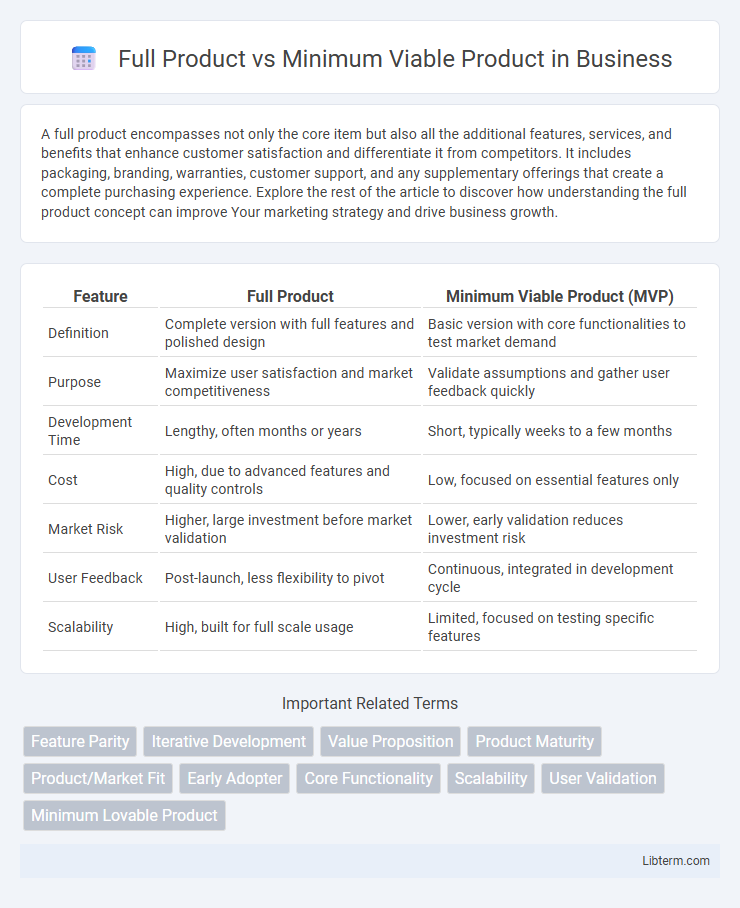A full product encompasses not only the core item but also all the additional features, services, and benefits that enhance customer satisfaction and differentiate it from competitors. It includes packaging, branding, warranties, customer support, and any supplementary offerings that create a complete purchasing experience. Explore the rest of the article to discover how understanding the full product concept can improve Your marketing strategy and drive business growth.
Table of Comparison
| Feature | Full Product | Minimum Viable Product (MVP) |
|---|---|---|
| Definition | Complete version with full features and polished design | Basic version with core functionalities to test market demand |
| Purpose | Maximize user satisfaction and market competitiveness | Validate assumptions and gather user feedback quickly |
| Development Time | Lengthy, often months or years | Short, typically weeks to a few months |
| Cost | High, due to advanced features and quality controls | Low, focused on essential features only |
| Market Risk | Higher, large investment before market validation | Lower, early validation reduces investment risk |
| User Feedback | Post-launch, less flexibility to pivot | Continuous, integrated in development cycle |
| Scalability | High, built for full scale usage | Limited, focused on testing specific features |
Understanding Full Product and Minimum Viable Product
A Full Product delivers complete features and functionalities designed to meet all user needs and provide maximum value, often requiring significant development time and resources. A Minimum Viable Product (MVP) includes only the essential features necessary to solve a core problem, enabling early market entry and user feedback collection for iterative improvements. Understanding the distinction helps businesses balance speed, cost, and product quality during development cycles.
Defining the Full Product Approach
The Full Product approach entails developing a complete, market-ready solution with all planned features and functionalities fully integrated before launch, ensuring comprehensive user experience and competitive positioning. This strategy emphasizes extensive design, rigorous testing, and polished performance to meet customer expectations and industry standards. Product teams prioritize delivering a highly refined, robust product that minimizes risk of early-stage flaws and maximizes long-term brand value.
What is a Minimum Viable Product (MVP)?
A Minimum Viable Product (MVP) is a version of a product with the core features necessary to satisfy early adopters and gather valuable user feedback. It enables startups and companies to test market hypotheses, reduce development costs, and iterate quickly based on real user data. MVPs prioritize functionality and usability over extensive features, facilitating faster time-to-market and informed product evolution.
Key Differences: Full Product vs MVP
A Full Product offers a complete set of features designed for the entire target market, ensuring maximum functionality and user satisfaction from launch. In contrast, a Minimum Viable Product (MVP) includes only the core features necessary to validate a concept and gather user feedback for iterating development. Key differences include scope, development time, investment level, and market readiness, with MVPs focusing on speed and learning while Full Products emphasize completeness and scalability.
Benefits of Launching a Full Product
Launching a full product provides comprehensive features and functionality that meet customer expectations, enhancing user satisfaction and brand reputation. It allows businesses to capture a larger market share by offering a complete solution, reducing the need for multiple updates or iterations. Full product launches also facilitate stronger competitive positioning and generate more immediate revenue streams through a fully realized value proposition.
Advantages of Starting with an MVP
Starting with a Minimum Viable Product (MVP) allows businesses to validate market demand with minimal investment, reducing financial risk and enabling rapid iteration based on real user feedback. MVPs accelerate time-to-market, helping companies quickly identify core features that resonate with customers while avoiding the costs associated with building a full product upfront. This lean approach enhances product-market fit and increases the likelihood of success by focusing development efforts on validated user needs before scaling.
Risks and Challenges: Full Product vs MVP
Developing a Full Product involves higher financial risk and longer time to market due to comprehensive features and extensive testing, which can lead to potential misalignment with customer needs if assumptions are incorrect. In contrast, a Minimum Viable Product (MVP) reduces initial investment and speeds up market entry but carries the challenge of limited functionality that may fail to capture early adopters or provide enough value for meaningful feedback. Both approaches require balancing risks between market validation, user experience, and resource allocation to ensure sustainable growth and product-market fit.
Choosing the Right Approach for Your Business
Choosing between a Full Product and a Minimum Viable Product depends on your business goals, target market, and resource availability. A Minimum Viable Product allows for rapid market entry and early user feedback, ideal for validating ideas with minimal investment. In contrast, a Full Product aims to deliver comprehensive features and a polished user experience, suited for businesses seeking immediate competitive differentiation and customer satisfaction.
Case Studies: Successes and Failures
Case studies of Full Product vs Minimum Viable Product (MVP) reveal distinct patterns of success and failure. Dropbox's MVP approach, launching a simple video demo before full development, validated demand and reduced time-to-market, leading to massive growth. Conversely, the failure of Google Glass's full product launch without sufficient user feedback highlighted risks of under-testing and misaligned market readiness, underscoring the importance of iterative MVP development.
Best Practices for Product Development Strategy
Focusing on best practices for product development strategy involves choosing between Full Product and Minimum Viable Product (MVP) approaches based on market needs and resource allocation. Emphasizing MVP enables rapid user feedback, iterative improvements, and risk mitigation, while Full Product development suits mature markets requiring comprehensive feature sets for competitive advantage. Prioritizing customer validation, agile methodologies, and cross-functional collaboration ensures alignment with business goals and maximizes product-market fit.
Full Product Infographic

 libterm.com
libterm.com